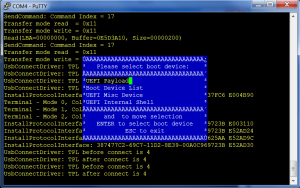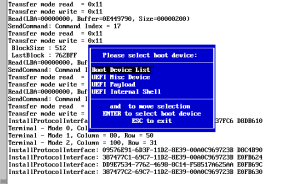Back in my blog post about Securing the Google SIP Stack, I did say I’d look at re-enabling SIP in Android-12, so with a view to doing that I tried building and booting LineageOS 19.1, but it crashed really early in the boot sequence (after the boot splash but before the boot animation started). It turns out that information on debugging the android early boot sequence is a bit scarce, so I thought I should write a post about how I did it just in case it helps someone else who’s struggling with a similar early boot problem.
How I usually Build and Boot Android
My builds are standard LineageOS with my patches to fix SIP and not much else. However, I do replace the debug keys with my signing keys and I also have an AVB key installed in the phone’s third party keyslot with which I sign the vbmeta for boot. This actually means that my phone is effectively locked but with a user supplied key (Yellow as google puts it).
My phone is now a pixel 3 (I had to say goodbye to the old Nexus One thanks to the US 3G turn off) and I do have a slightly broken Pixel 3 I play with for experimental patches, which is where I was trying to install Android-12.
Signing Seems to be the Problem
Just to verify my phone could actually boot a stock LineageOS (it could) I had to unlock it and this lead to the discovery that once unlocked, it would also boot my custom rom as well, so whatever was failing in early boot seemed to be connected with the device being locked.
I also discovered an interesting bug in the recovery rom fastboot: If you’re booting locked with your own keys, it will still let you perform all the usually forbidden fastboot commands (the one I was using was set_active). It turns out to be because of a bug in AOSP which treats yellow devices as unlocked in fastboot. Somewhat handy for debugging, but not so hot for security …
And so to Debugging Early Boot
The big problem with Android is there’s no way to get the console messages for early boot. Even if you enable adb early, it doesn’t get started until quite far in to the boot animation (which was way after the crash I was tripping over). However, android does have a pstore (previously ramoops) driver that can give you access to the previously crashed boot’s kernel messages (early init, fortunately, mostly logs to the kernel message log).
Forcing init to crash on failure
Ordinarily an init failure prints a message and reboots (to the bootloader), which doesn’t excite pstore into saving the kernel message log. fortunately there is a boot option (androidboot.init_fatal_panic) which can be set in the boot options (or kernel command line for a pixel-3 which can only boot the 4.9 kernel). If you build your own android, it’s fairly easy to add things to the android commandline (which is in boot.img) because all you need to do is extract BOOT/cmdline from the intermediate zip file you sign add any boot options you need and place it back in the zip file (before you sign it).
Unfortunately, this expedient didn’t work (no console logs appear in pstore). I did check that init was correctly panic’ing on failure by inducing an init failure in recovery mode and observing the panic (recovery mode allows you to run adb). But this induced panic also didn’t show up in pstore, meaning there’s actually some problem with pstore and early panics.
Security is the problem (as usual)
The actual problem turned out to be security (as usual): The pixel-3 does encrypted boot panic logs. The way this seems to work (at least in my reading of the google additional pstore patches) is that the bootloader itself encrypts the pstore ram area with a key on the /data partition, which means it only becomes visible after the device is unlocked. Unfortunately, if you trigger a panic before the device is unlocked (by echoing ‘c’ to /proc/sysrq-trigger) the panic message is lost, so pstore itself is useless for debugging early boot. There seems to be some communication of the keys by the vendor proprietary ramoops binary making it very difficult to figure out how it’s being done.
Why the early panic message is lost is a bit mysterious, but unfortunately pstore on the pixel-3 has several proprietary components around the encrypted message handling that make it hard to debug. I suspect if you don’t set up the pstore encryption keys, the bootloader erases the pstore ram area instead of encrypting it, but I can’t prove that.
Although it might be possible to fix the pstore drivers to preserve the ramoops from before device unlock, the participation of the proprietary bootloader in preserving the memory doesn’t make that look like a promising avenue to explore.
Anatomy of the Pixel-3 Boot Sequence
The Pixel-3 device boots through recovery. What this means is that the initial ramdisk (from boot.img) init is what boots both the recovery and normal boot paths. The only difference is that for recovery (and fastboot), the device stays in the ramdisk and for normal boot it mounts the /system partition and pivots to it. What makes this happen or not is the boot flag androidboot.force_normal_boot=1 which is added by the bootloader. Pretty much all the binary content and init rc files in the ramdisk are for recovery and its allied menus.
Since the boot paths are pretty radically different, because the normal boot first pivots to a first stage before going on to a second, but in the manner of containers, it might be possible to boot recovery first, start a dmesg logger and then re-exec init through the normal path
Forcing Re-Exec
The idea is to signal init to re-exec itself for the normal path. Of course, there have to be a few changes to do this: An item has to be added to the recovery menu to signal init and init itself has to be modified to do the re-exec on the signal (note you can’t just kick off an init with a new command line because init must be pid 1 for booting). Once this is done, there are problems with selinux (it won’t actually allow init to re-exec) and some mount moves. The selinux problem is fixable by switching it from enforcing to permissive (boot option androidboot.selinux=permissive) and the mount moves (which are forbidden if you’re running binaries from the mount points being moved) can instead become bind mounts. The whole patch becomes 31 insertions across 7 files in android_system_core.
The signal I chose was SIGUSR1, which isn’t usually used by anything in the bootloader and the addition of a menu item to recovery to send this signal to init was also another trivial patch. So finally we have a system from which I can start adb to trace the kernel log (adb shell dmesg -w) and then signal to init to re-exec. Surprisingly this worked and produced as the last message fragment:
[ 190.966881] init: [libfs_mgr]Created logical partition system_a on device /dev/block/dm-0
[ 190.967697] init: [libfs_mgr]Created logical partition vendor_a on device /dev/block/dm-1
[ 190.968367] init: [libfs_mgr]Created logical partition product_a on device /dev/block/dm-2
[ 190.969024] init: [libfs_mgr]Created logical partition system_ext_a on device /dev/block/dm-3
[ 190.969067] init: DSU not detected, proceeding with normal boot
[ 190.982957] init: [libfs_avb]Invalid hash size:
[ 190.982967] init: [libfs_avb]Failed to verify vbmeta digest
[ 190.982972] init: [libfs_avb]vbmeta digest error isn't allowed
[ 190.982980] init: Failed to open AvbHandle: No such file or directory
[ 190.982987] init: Failed to setup verity for '/system': No such file or directory
[ 190.982993] init: Failed to mount /system: No such file or directory
[ 190.983030] init: Failed to mount required partitions early …
[ 190.983483] init: InitFatalReboot: signal 6
[ 190.984849] init: #00 pc 0000000000123b38 /system/bin/init
[ 190.984857] init: #01 pc 00000000000bc9a8 /system/bin/init
[ 190.984864] init: #02 pc 000000000001595c /system/lib64/libbase.so
[ 190.984869] init: #03 pc 0000000000014f8c /system/lib64/libbase.so
[ 190.984874] init: #04 pc 00000000000e6984 /system/bin/init
[ 190.984878] init: #05 pc 00000000000aa144 /system/bin/init
[ 190.984883] init: #06 pc 00000000000487dc /system/lib64/libc.so
[ 190.984889] init: Reboot ending, jumping to kernelWhich indicates exactly where the problem is.
Fixing the problem
Once the messages are identified, the problem turns out to be in system/core ec10d3cf6 “libfs_avb: verifying vbmeta digest early”, which is inherited from AOSP and which even says in in it’s commit message “the device will not boot if: 1. The image is signed with FLAGS_VERIFICATION_DISABLED is set 2. The device state is locked” which is basically my boot state, so thanks for that one google. Reverting this commit can be done cleanly and now the signed image boots without a problem.
I note that I could also simply add hashtree verification to my boot, but LineageOS is based on the eng target, which has FLAGS_VERIFICATION_DISABLED built into the main build Makefile. It might be possible to change it, but not easily I’m guessing … although I might try fixing it this way at some point, since it would make my phones much more secure.
Conclusion
Debugging android early boot is still a terribly hard problem. Probably someone with more patience for disassembling proprietary binaries could take apart pixel-3 vendor ramoops and figure out if it’s possible to get a pstore oops log out of early boot (which would be the easiest way to debug problems). But failing that the simple hack to re-exec init worked enough to show me where the problem was (of course, if init had continued longer it would likely have run into other issues caused by the way I hacked it).

